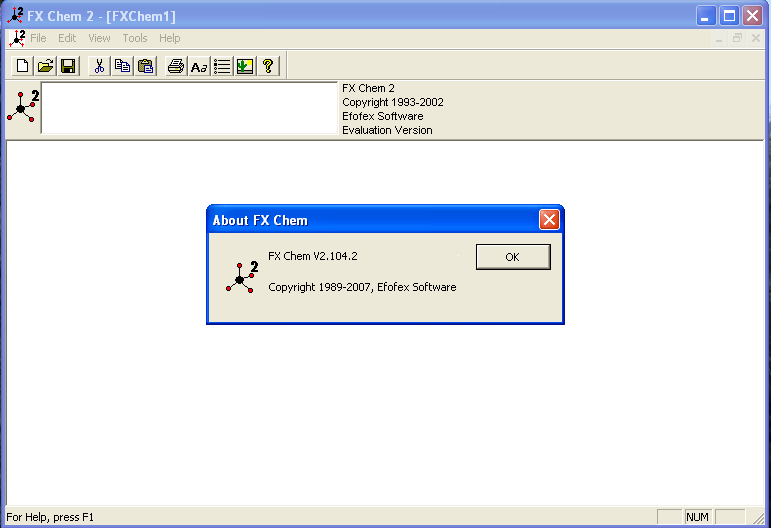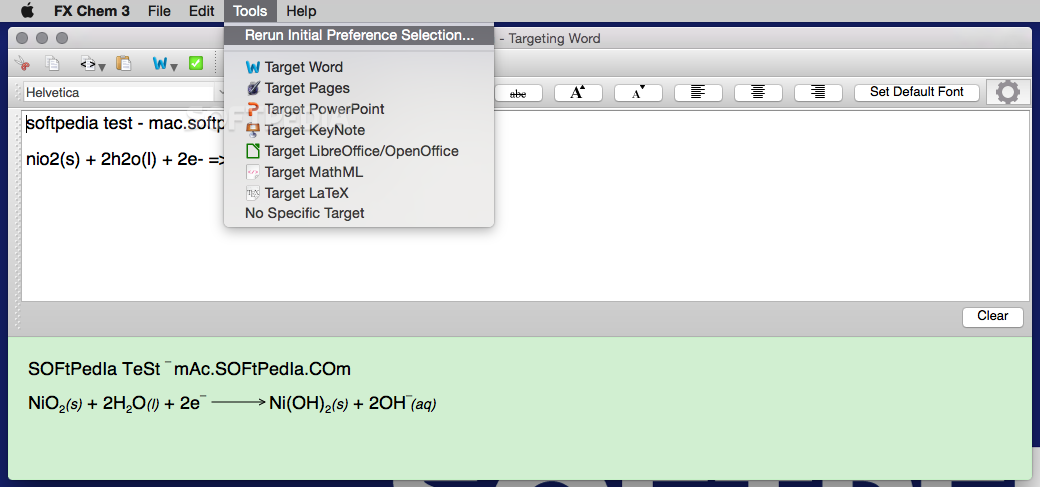The PM material code designation or identifying code in the case of structural PM parts defines a specific material as to chemical composition and minimum strength expressed in 103 psi. For example, FC-0208-60 is a PM copper steel material containing nominally 2% copper and 0.8% combined carbon possessing a minimum yield strength of 60 X 103 psi (60,000 psi) (410 MPa) in the as-sintered condition.
FX Chem makes writing chemical equations dead simple. You just type and FX Chem knows enough about chemistry to put all of the components of the equation into the right spots. FX Chem can even produce nuclear chemistry equations - something that is very difficult in. The X-Chem drug discovery engine is based on a library generated by iterative combinatorial synthesis of small molecules tethered to DNA tags that record the synthetic history of the small molecule. Every small molecule in the library has a unique DNA barcode attached it. The library is screened as a mixture using affinity-based binding to. Trusted Mac download FX Chem 3 3.003.3. Virus-free and 100% clean download. Get FX Chem 3 alternative downloads. FX ChemStruct is a useful utility that can save you a lot of time if you work with chemical structures. The fact that it automatically detects and draws atomic bonds gives you more flexibility.
A coding system offers a convenient means for designating both the chemical composition and minimum strength value of any standard PM material. It is based on the system established by the industry with the addition of a two-or three-digit suffix representing minimum strength in place of a suffix letter indicating density range. The density is given for each standard material as one of the typical values.
Code designations in this Standard and revisions thereof apply only to PM materials for which MPIF Standards have been adopted. In order to avoid confusion, the MPIF coding system is intended for use only with such materials and should not be used to create non-standard materials. The explanatory notes, property values, and other contents of this Standard have no application to any other materials.
In the coding system, the prefix letters denote the general type of material. For example, the prefix 'CT' represents copper (C) and tin (T) which is known as bronze.
Prefix Letter Code | |||
A | Aluminum | FS | Iron Silicon |
C | Copper | FX | Copper-Infiltrated Iron or Steel |
CT | Bronze | FY | Iron Phosphorus |
CNZ | Nickel-Silver | G | Free Graphite |
CZ | Brass | M | Manganese |
F | Iron | N | Nickel |
FC | Iron-Copper or Copper Steel | P | Lead |
FD | Diffusion-Alloyed Steel | S | Silicon |
FF | Soft-Magnetic Iron | SS | Stainless Steel (prealloyed) |
FL | Prealloyed Ferrous material except Stainless Steel | T | Tin |
FLD | Diffusion-Alloyed Steel (prealloyed base) | U | Sulfur |
FN | Iron-Nickel or Nickel Steel | Y | Phosphorus |
| Z | Zinc | ||
Prefix and Numeric Code

The numeric code following the prefix letter code refers to the composition of the material.
In nonferrous materials, the first two numbers in the numeric code designate the percentage of the major alloying constituent. The last two numbers of the numeric code designate the percentage of the minor alloying constituent.
For improved machinability lead is sometimes the third alloying element in a nonferrous alloy system. Lead will only be indicated by the letter 'P' in the prefix. The percentage of lead or any other minor alloying element that is excluded from the numeric code is represented in the 'Chemical Composition' that appears with each standard material.
In ferrous materials, the major alloying elements (except combined carbon) are included in the prefix letter code. Other elements are excluded from the code but are represented in the 'Chemical Composition' that appears with each Standard material. The first two digits of the numeric code indicate the percentage of the major alloying constituent present.
Combined carbon content in ferrous materials is designated by the last two digits in the numeric code. The individual chemical composition tables show limits of carbon content for each alloy.
The range of carbon that is metallurgically combined is indicated by the coding system. The combined carbon level can be estimated metallographically for sintered PM steels that have a well-defined ferrite/pearlite microstructure. For compositions with very low allowable carbon levels (< 0.08 %) total carbon determined analytically (ASTM E1019) is the recommended method.
NOTE: When a clear pearlite to ferrite ratio cannot be determined metallographically, such as with heat treated steels and materials made from prealloyed base powders or diffusion-alloyed powders, then determination of combined carbon by normal metallographic methods is not practical. It is recommended that the carbon content of these materials should be reported as total carbon using the combustion method (ASTM E1019). The test method used should be identified in the report and identified as metallurgically combined carbon or total carbon. While total carbon will approximate the combined carbon in many materials, free graphite and other carbonaceous material will raise the total carbon content above the level of combined carbon, possibly causing the total carbon content to exceed the combined carbon level specified for the material.
In the case of PM stainless steels and PM prealloyed low-alloy steels, the numeric code is replaced with a designation derived from modifications of the American Iron and Steel Institute alloy coding system, e.g., SS-316L-15, FL-4605-100HT.
When a prealloyed steel powder is modified with elemental additions to create a hybrid low-alloy steel or a sinter-hardened steel, an alpha-numeric designator is used, e.g. FLN-4205-40, FLN2-4405-120HT or FLN4C-4005-60. If the base prealloyed composition has been modified (slight change to increase or decrease one or two elements) then a numeric designator will be added to the material designation code immediately after the first two digits for the prealloyed grade, e.g., FLC-48108-50HT.


As with other PM materials, the suffix number denotes the specified minimum strength value expressed in 103 psi.
In the case of soft-magnetic alloys, the phosphorus containing irons are treated differently, since the amount of phosphorus is usually less than 1%. To indicate more accurately the nominal amount of phosphorus the code takes the nominal percent phosphorus, multiplies by 100 and uses this number for the first two digits in the code. The last two digits remain '00' since no carbon is required. For example, the iron-0.45% phosphorus alloy would be designated as: FY-4500.
Suffix Digit Code
The two- or three-digit suffix represents the minimum strength value, expressed in 103 psi, that the user can expect from the PM material possessing that chemical composition. In the as-sintered condition the strength is tensile yield; in the heat treated condition, it is ultimate tensile.
Examples of PM Material Designation Coding | |||
Material | Nominal Compositions by Percent | Complete Code for Material, Composition & Minimum Strength (103 psi) | |
PM Bronze | Cu-90, SN-10 | CT-1000-13 | |
PM Nickel-Silver | Cu-64, NI-18, Zn-18 | CNZ-1818-17 | |
PM Nickel-Silver | Cu-64, Ni-18, Zn-16, Pb-2 | CNZP-1816-13 | |
PM Brass | Cu-90, Zn-10 | CZ-1000-11 | |
PM Brass | Cu-78, Zn-20, Pb-2 | CZP-2002-12 | |
As-sintered | Heat Treated | ||
PM Iron | Fe, 99, C-0.2 | F-0000-20 | --- |
PM Steel | Fe, 98, C-0.8 | F-0008-38 | F-0008-85HT |
PM Copper Steel | Fe, 96, Cu-2, C-0.8 | FC-0208-60 | FC-0209-95HT |
| PM Nickel Steel | Fe, 96, Ni-2, C-0.5 | FN-0205-35 | FN-0205-180HT |
PM Infiltrated Iron | Fe, 78, Cu-20 | FX-2000-25 | --- |
PM Infiltrated Steel | Fe, 77, Cu-20, C-0.8 | FX-2008-60 | FX-2008-90HT |
PM Phosphorus Iron | Fe, P-0.45 | FY-4500-20W | --- |
PM Stainless Steel (austenitic) | AISI 316 (modified) | SS-316N1-25 | --- |
PM Stainless Steel (martensitic) | AISI 410 (modified) | SS-410-90HT | |
PM 4600 Steel (prealloyed) | AISI 4600 (modified), C-0.5 | FL-4605-45 | FL-4605-140HT |
PM 4200 Steel (hybrid low-allow) | AISI 4200 (modified), Ni-1.5, C-0.5 | FLN-4205-40 | FLN-4205-105HT |
Suffix Letter Code
Fx Chemicals
When the code designation 'HT' appears after the suffix digits it is understood that the PM material specified has been heat treated (quench hardened and tempered or sinter-hardened) and that the strength represented is ultimate tensile in 103psi.

In the case of the soft-magnetic alloys the suffix does NOT designate yield or tensile strength, but rather the maximum coercive field strength (10 times the value in oersteds) and an alphabetic designator for the minimum density as follows:
Designator | Minimum |
U | 6.5 |
V | 6.7 |
W | 6.9 |
X | 7.1 |
Y | 7.3 |
Z | 7.4 |
For example, a pure iron material at a minimum density of 6.9 g/cm3 and coercive field strength of 2.3 Oe would be designated as F-0000-23W. The iron-0.45% phosphorus alloy at a 7.1 g/cm3 minimum density and coercive field strength of 2.0 Oe would be designated as FY-4500-20X.
Fx Chemo
Disclaimer: The contents of this website are intended to be used as a reference for educational and/or comparison purposes. No position should be taken by the user with respect to the validity of the contents of the website. For verification, the user should seek the opinion of a certified laboratory. Neither MPIF nor any of its members assumes or accepts any liability resulting from the use of this website.


Comments are closed.